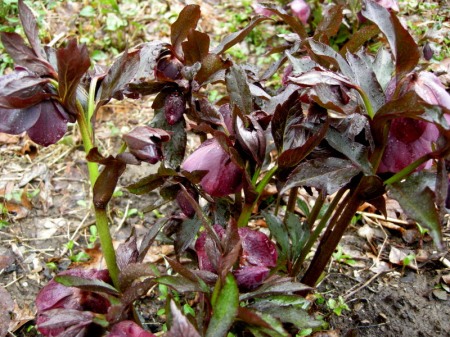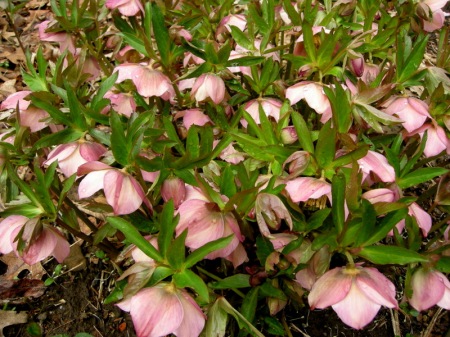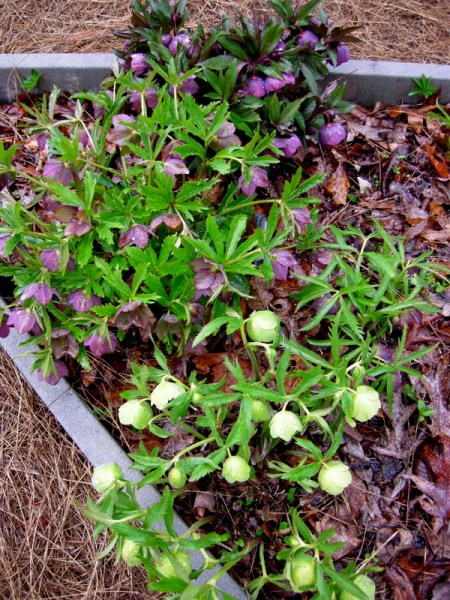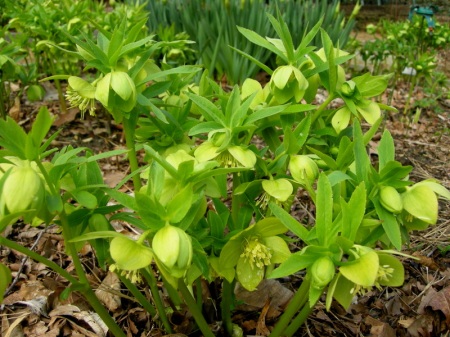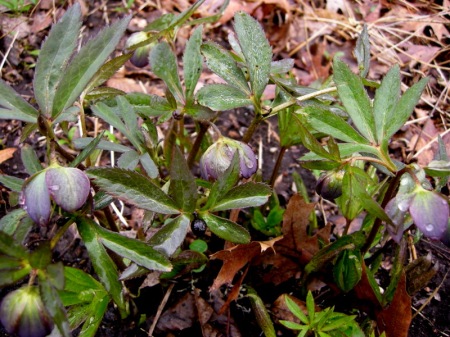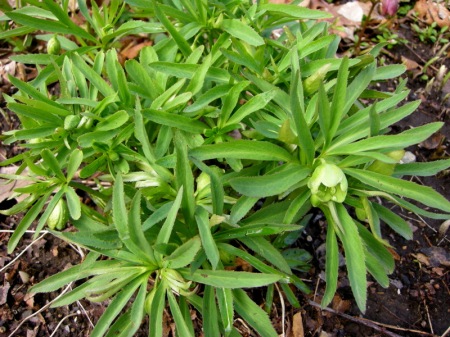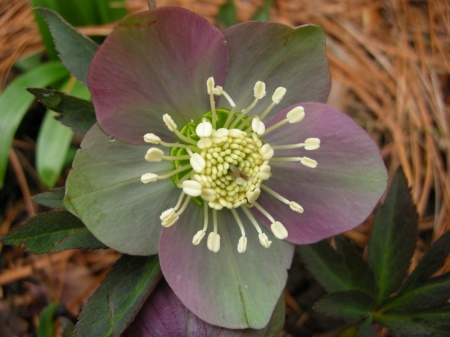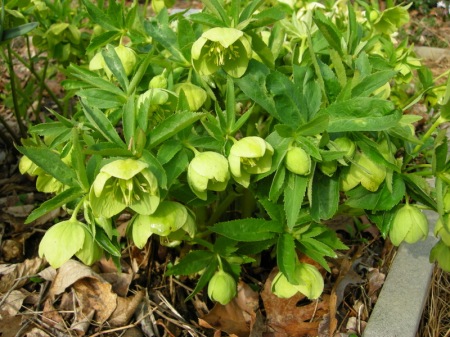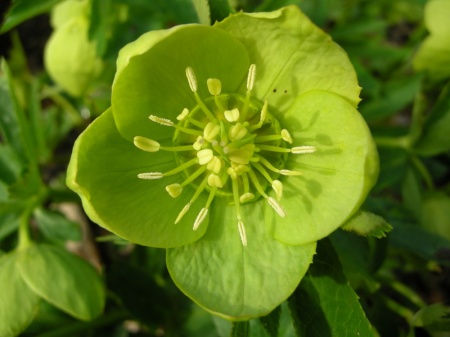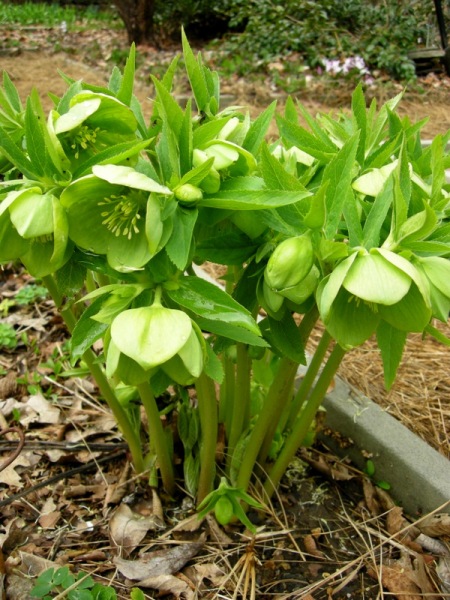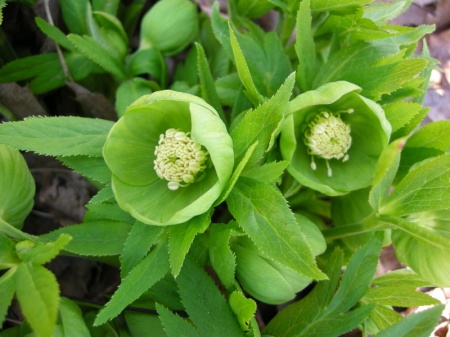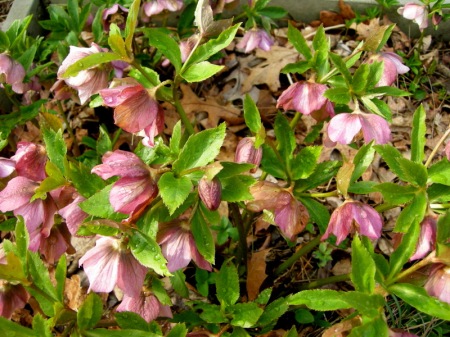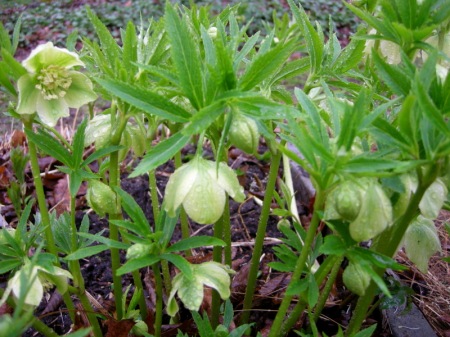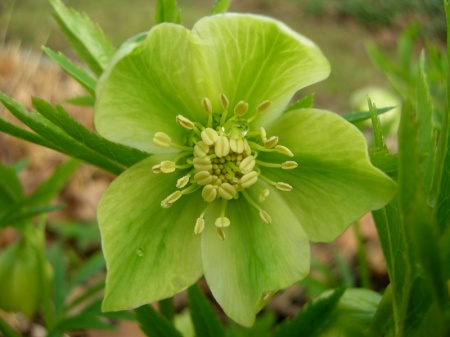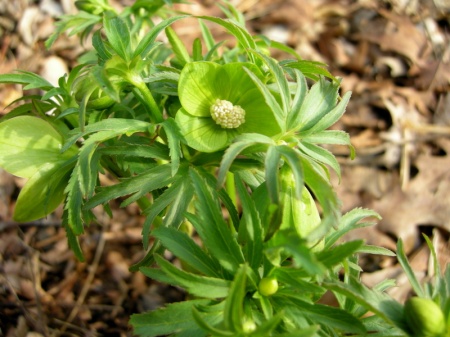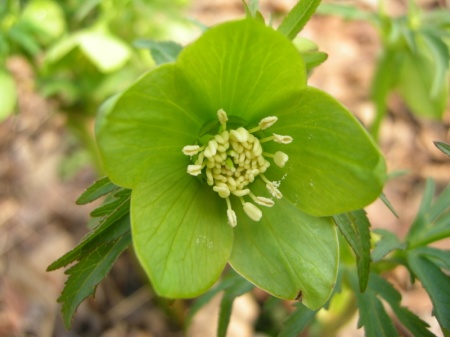Carolyn’s Shade Gardens is a retail nursery located in Bryn Mawr, PA, specializing in showy, colorful, and unusual plants for shade. The only plants that we ship are snowdrops within the US. For catalogues and announcements of local events, please send your full name, mailing address, and cell number to carolyn@carolynsshadegardens.com and indicate whether you are interested in snowdrops, hellebores, and/or hostas. Click here to get to the home page of our website for catalogues and information about our nursery and to subscribe to our blog.
 I have had this gorgeous double purple hellebore in my garden for several years but it has never bloomed this early. Photo 1/7/12
I have had this gorgeous double purple hellebore in my garden for several years but it has never bloomed this early. Photo 1/7/12
It is the middle of the month and time to participate in Garden Blogger’s Bloom Day hosted by May Dreams Gardens (link available on December 15) where gardeners from all over the world publish photos of what’s blooming in their gardens. I participate because it is fun and educational for me to identify what plants make my gardens shine at different times of the year. This month I hope that my nursery customers and blog readers will get some ideas for plants to add to their own gardens to extend their season through winter.
My garden is located in Bryn Mawr (outside Philadelphia), Pennsylvania, U.S., in zone 6B.
 ‘Mrs. Betty Ranicar’ is usually one of my first hybrid hellebores to bloom but this is early even for her.
‘Mrs. Betty Ranicar’ is usually one of my first hybrid hellebores to bloom but this is early even for her.
Last January, the whole garden was under snow, and I didn’t even participate in GBBD. This year couldn’t be more different with 7 days in the 50s (10C) and 6 days at 60 degrees (16C) or above since December 15. Frankly, I find it extremely worrisome, but it means that I didn’t have to go searching for plants peaking between December 15 and January 15. There are a few other plants worth featuring, but my hellebores are all blooming early so I call this post Hellebores on Parade. For the benefit of my customers, I will note which hellebores will be for sale at Carolyn’s Shade Gardens (CSG) this spring.
 ‘Pink Tea Cup’ has the best pink color of any hybrid hellebore and was the first to come into bloom this season ( for sale at CSG this spring). Photo 1/9/12
‘Pink Tea Cup’ has the best pink color of any hybrid hellebore and was the first to come into bloom this season ( for sale at CSG this spring). Photo 1/9/12
 ‘Jacob’ Christmas rose just keeps going and going with new white flowers appearing and mixing with the older pink flowers for a gorgeous effect, see below (for sale at CSG). Photo 12/31/11
‘Jacob’ Christmas rose just keeps going and going with new white flowers appearing and mixing with the older pink flowers for a gorgeous effect, see below (for sale at CSG). Photo 12/31/11
 ‘Jacob’ Christmas rose with Camellia x ‘Winter’s Joy’. Photo 1/2/12
‘Jacob’ Christmas rose with Camellia x ‘Winter’s Joy’. Photo 1/2/12
 Flowers are emerging on the hellebore species cross ‘HGC Pink Frost’ (for sale at CSG). Notice the dark red to burgundy highlights on the leaves and stems and the amazing color of the buds. As noted in Cutting Back Hellebores, I leave the foliage on to make a nice backdrop for the flowers. Photo 12/31/11
Flowers are emerging on the hellebore species cross ‘HGC Pink Frost’ (for sale at CSG). Notice the dark red to burgundy highlights on the leaves and stems and the amazing color of the buds. As noted in Cutting Back Hellebores, I leave the foliage on to make a nice backdrop for the flowers. Photo 12/31/11
 ‘Praecox’ Christmas rose is also blooming at least a month earlier than usual. Photo 12/31/11
‘Praecox’ Christmas rose is also blooming at least a month earlier than usual. Photo 12/31/11
 The hellebore species cross ‘HGC Winter’s Song’ is now fully in bloom. Photo 1/10/12
The hellebore species cross ‘HGC Winter’s Song’ is now fully in bloom. Photo 1/10/12
 The rare species Helleborus dumetorum (no common name) continues to bloom (for sale at CSG). It is deciduous so all the “leaves” in the photo are actually flower bracts. The leaves will come up later. Photo 12/31/11
The rare species Helleborus dumetorum (no common name) continues to bloom (for sale at CSG). It is deciduous so all the “leaves” in the photo are actually flower bracts. The leaves will come up later. Photo 12/31/11
 This beautiful, pure white, outward-facing hellebore called ‘Snow White’ (aka ‘Snow Bunting’) is an extremely rare cross between hybrid hellebore and Christmas rose—something that was thought to be impossible (for sale at CSG). Photo 1/9/12
This beautiful, pure white, outward-facing hellebore called ‘Snow White’ (aka ‘Snow Bunting’) is an extremely rare cross between hybrid hellebore and Christmas rose—something that was thought to be impossible (for sale at CSG). Photo 1/9/12
 The lighter chartreuse buds of bearsfoot hellebore, H. foetidus, are becoming more prominent and will remain ornamental through May (for sale at CSG). Photo 1/10/12
The lighter chartreuse buds of bearsfoot hellebore, H. foetidus, are becoming more prominent and will remain ornamental through May (for sale at CSG). Photo 1/10/12
 Another look at the hybrid hellebore “Double Purple” (for sale at CSG). Photo 1/7/12
Another look at the hybrid hellebore “Double Purple” (for sale at CSG). Photo 1/7/12
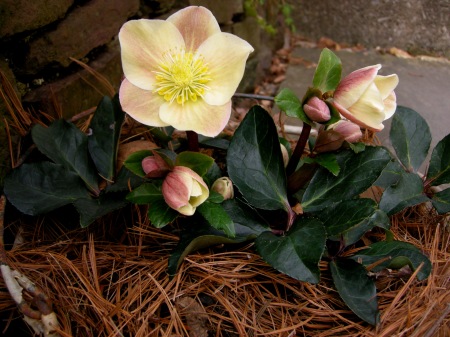 My new favorite this year, hellebore species cross ‘HGC Cinnamon Snow’ (for sale at CSG). I like it so much that I decided to put it in a basket by my front door. Photo 1/9/12
My new favorite this year, hellebore species cross ‘HGC Cinnamon Snow’ (for sale at CSG). I like it so much that I decided to put it in a basket by my front door. Photo 1/9/12
There are some other plants looking great in my garden besides hellebores. Most of the fall-blooming camellias still have viable buds but no flowers open to show you. They will continue to bloom if the weather cooperates. Here are the non-hellebore stars:
 My un-named Korean Camellia japonica, which blooms in the spring and fall, continues to produce flowers. Photo 1/9/12
My un-named Korean Camellia japonica, which blooms in the spring and fall, continues to produce flowers. Photo 1/9/12
 Camellia x ‘Elaine Lee’ also has buds, and look at those shiny leaves. Photo 1/10/12
Camellia x ‘Elaine Lee’ also has buds, and look at those shiny leaves. Photo 1/10/12
 Camellia x ‘Winter’s Joy’ has been flowering since October and is still covered with buds but none are open right now.
Camellia x ‘Winter’s Joy’ has been flowering since October and is still covered with buds but none are open right now.
 The buds on my variegated winter daphne, D. odora ‘Aureomarginata’, are coloring up early. It is the sole survivor of five shrubs I put in this spring. Although I gave them excellent drainage, they just couldn’t tolerate all the rain we had in August and September. One by one they wilted from too much water and died, while this one remained healthy. Photo 1/9/12
The buds on my variegated winter daphne, D. odora ‘Aureomarginata’, are coloring up early. It is the sole survivor of five shrubs I put in this spring. Although I gave them excellent drainage, they just couldn’t tolerate all the rain we had in August and September. One by one they wilted from too much water and died, while this one remained healthy. Photo 1/9/12
 If we have cold weather, winter jasmine, Jasminum nudiflorum, blooms in February, but right now it is opening flowers continuously. Photo 1/10/12
If we have cold weather, winter jasmine, Jasminum nudiflorum, blooms in February, but right now it is opening flowers continuously. Photo 1/10/12
 The only snowdrop in bloom right now is the giant snowdrop, Galanthus elwesii (for sale at CSG). Photo 1/9/12
The only snowdrop in bloom right now is the giant snowdrop, Galanthus elwesii (for sale at CSG). Photo 1/9/12
 My fall-flowering snowdrop ‘Potter’s Prelude’ has finished blooming, but I wanted to show you its beautiful leaves (for sale at CSG). Photo 1/1/12
My fall-flowering snowdrop ‘Potter’s Prelude’ has finished blooming, but I wanted to show you its beautiful leaves (for sale at CSG). Photo 1/1/12
On New Year’s Day, my husband and I went walking in the Pinetum at the Haverford College Arboretum, a wonderful local treasure. We saw two unusual conifers with great texture that I wanted to share:
 Longleaf pine, Pinus palustris, is native from Virginia to Texas but is not usually found around here.
Longleaf pine, Pinus palustris, is native from Virginia to Texas but is not usually found around here.
 I love firs, and the texture of this Algerian fir, Abies numidica, really stood out.
I love firs, and the texture of this Algerian fir, Abies numidica, really stood out.
I dedicate this post to Bob Stewart, my friend and horticulturalist extraordinaire, who died on December 16, 2011. Bob and his wife Brigitta started the amazing nursery Arrowhead Alpines in Fowlersville, MI. If you haven’t visited their site, you should by clicking here. Bob will be greatly missed.
Carolyn
Notes: Every word that appears in orange on my blog is a link that you can click for more information. If you want to return to my blog’s homepage to access the sidebar information (catalogues, previous articles, etc.) or to subscribe to my blog, just click here.




























